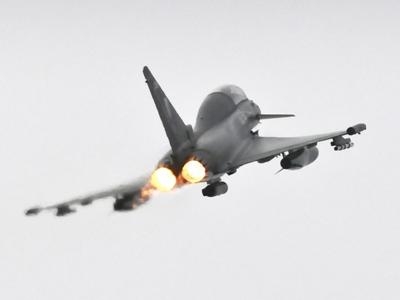Sat, Apr 14, 2012
Quick Reaction Alert Force Responded To Helicopter Transmitting Emergency Signal
Two RAF Typhoons were launched yesterday evening to intercept an aircraft that was transmitting an emergency signal and could not be identified via radio. The RAF jets are part of the Quick Reaction Alert (QRA) force which has Typhoon fighter aircraft and crews held at continuous ground-readiness at RAF Coningsby in Lincolnshire, and at RAF Leuchars in Fife.

Thusday night, two QRA Typhoons were scrambled from RAF Coningsby when a small civilian aircraft was transmitting inadvertently on an emergency frequency and was out of radio communication with Air Traffic Control. Authorization was given for one of the Typhoons to transit at supersonic speed over land, which resulted in a sonic boom heard by the public.
The Typhoons intercepted a civilian Gazelle helicopter in the vicinity of Bristol, and, after identification, the helicopter successfully re-established communications with Air Traffic Control.The reason for the emergency signal and communications failure is yet to be determined.
The MOD will be providing all available information on the intercept to the Department for Transport who will lead on the investigation process in order to complete any follow-up action if considered appropriate, and to also try and reduce the chance of any repetition of this type of incident.
Deterrence is a key part of our Quick Reaction Alert posture. The RAF's air defence capability to detect and deter aircraft approaching UK sovereign airspace is just one aspect of a multilayered approach that the UK Government takes to protect UK and NATO-monitored airspace.
The QRA force's purpose is to identify any aircraft approaching or within national airspace without prior approval or not having identified themselves and which cannot be identified by any other means, i.e. the aircraft is not talking to civilian or military Air Traffic Control, has not filed a flight plan and is not transmitting a recognisable secondary surveillance radar code.
QRA aircraft can take off within minutes to protect UK sovereign airspace. (Image provided by the RAF)
More News
He Attempted To Restart The Engine Three Times. On The Third Restart Attempt, He Noticed That Flames Were Coming Out From The Right Wing Near The Fuel Cap Analysis: The pilot repor>[...]
Make Sure You NEVER Miss A New Story From Aero-News Network Do you ever feel like you never see posts from a certain person or page on Facebook or Instagram? Here’s how you c>[...]
From 2009 (YouTube Edition): Leading Air Show Performers Give Their Best Advice for Newcomers On December 6th through December 9th, the Paris Las Vegas Hotel hosted over 1,500 air >[...]
Aero Linx: NASA ASRS ASRS captures confidential reports, analyzes the resulting aviation safety data, and disseminates vital information to the aviation community. The ASRS is an i>[...]
“For our inaugural Pylon Racing Seminar in Roswell, we were thrilled to certify 60 pilots across our six closed-course pylon race classes. Not only did this year’s PRS >[...]
 NTSB Final Report: Rutan Long-EZ
NTSB Final Report: Rutan Long-EZ ANN FAQ: Turn On Post Notifications
ANN FAQ: Turn On Post Notifications Classic Aero-TV: ICAS Perspectives - Advice for New Air Show Performers
Classic Aero-TV: ICAS Perspectives - Advice for New Air Show Performers ANN's Daily Aero-Linx (06.28.25)
ANN's Daily Aero-Linx (06.28.25) Aero-News: Quote of the Day (06.28.25)
Aero-News: Quote of the Day (06.28.25)



